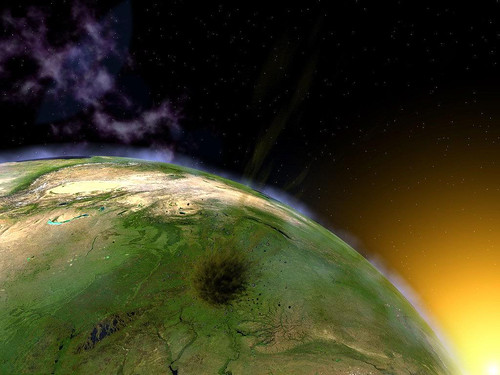 In a recent article from LiveScience.com, it’s been discovered that Antarctica used to be 30 degrees warmer than it is today. The piece by Andrea Thompson reports:
In a recent article from LiveScience.com, it’s been discovered that Antarctica used to be 30 degrees warmer than it is today. The piece by Andrea Thompson reports:A college student’s new discovery of fossils collected in the East Antarctic suggests that the frozen polar cap was once a much balmier place.Considering that in 2007 an “international panel of climate scientists said…that there is an overwhelming probability that human activities are warming the planet at a dangerous rate, with consequences that could soon take decades or centuries to reverse,” this warm period was obviously caused by our ancestors 14 million years ago.
The well-preserved fossils of ostracods, a type of small crustaceans, came from the Dry Valleys region of Antarctica’s Transantarctic Mountains and date from about 14 million years ago. The fossils were a rare find, showing all of the ostracods’ soft anatomy in 3-D.
[…]
Because ostracods couldn’t survive in the current Antarctic climate, their presence suggests that the southern-most continent hasn’t always been as frigid as it is today.
“Present conditions in this Antarctic region show mean annual temperatures of minus 25 degrees C (Celsius) [minus 13 degrees Fahrenheit],” said Mark Williams of the University of Leicester, co-author with Ashworth of the fossil-find report in the journal Proceedings of the Royal Society B. “These are impossible conditions to sustain a lake fauna with ostracods.”
The authors think the ostracods and the habitat they lived in were the last vestiges of a tundra ecosystem, similar to those found in Patagonia, that once thrived in Antarctic coastal regions, before an intense period of cooling gave rise to the Antarctic environment we see today.
While geologists theorize that the land that now makes up Antarctica was once a part of other continents closer to the equator—hundreds of millions of years ago—the warmer climate that supported the ostracods would have existed “when Antarctica was pretty much in its current location,” said study co-author David Marchant of Boston University.
Marchant estimated that the summer temperatures in Antarctica would have been about 30.6 degrees F (17 degrees C) warmer than they are now.
This warmer period started to end when the first continent-sized ice sheets began appearing on Antarctica around 34 million years ago, around the end of the Eocene epoch. These ice sheets expanded and contracted until around 14 million years ago, during the Miocene epoch, when a dramatic cooling took place and transformed the tundra into an environment “that today looks like Mars,” Marchant told LiveScience.
Marchant said climatologists are uncertain exactly what caused this intense period of cooling.
Now, I know what you’re thinking: scientifically speaking, humans didn’t even exist 14 million years ago. Homo erectus didn’t exist until about 1.5 million years ago, and Ardipithecus, a “proto-human,” was around as early as 5.5 million years ago. How could humans have caused a warm period 14 million years ago?
Come on, folks. We’re trying to save the planet here; don’t let science get in the way. Besides, Al Gore might be able to make a few dollars from this.
Since he has a company, Generation Investment Management LLP, which accepts money for carbon-credits (to supposedly “invest” in environmentally-friendly energy ideas), you can pay him if you feel guilty for this prehistoric heat wave. Sometimes he even pays himself for when he wants to do something environmentally-unfriendly.
Gore is also the chairman of The Alliance for Climate Protection, which is the “beneficiary of the probable millions of dollars raised by the Live Earth concerts” according to Jourdan Rassás of Earth 911. Oddly enough, a year later I still can’t find any information on the exact dollar amount that Gore’s group made on the concerts. Rassás predicted in 2007 that it would “most likely be substantial, considering some of the tickets for the London concert were going for more than 500 US dollars.”
What we do know about Live Earth, however, was how much pollution was created by concert-goers, musicians in their private jets flying around the globe, and the creation of electricity to power the events. According to the Daily Mail:
The total carbon footprint of the event, taking into account the artists’ and spectators’ travel to the concert, and the energy consumption on the day, is likely to be at least 31,500 tons of carbon emissions, according to John Buckley of Carbonfootprint.com, who specializes in such calculations.It’s a good thing that Gore used to be part of a zinc mine that polluted the environment. That probably gives him an upper-hand on understanding these things. Oh, you didn’t know about the zinc mine? Not too many people do, but Al and wife Tipper received royalties from it for 27 years and in 2007 USA Today reported:
Throw in the television audience and it comes to a staggering 74,500 tons. In comparison, the average Briton produces ten tons in a year.
The concert will also generate some 1,025 tons of waste at the concert stadiums—much of which will go directly into landfill sites.
CARTHAGE, Tenn. — Al Gore has profited from zinc mining that has released millions of pounds of potentially toxic substances near his farmstead, but there is no evidence the mine has caused serious damage to the environment in the area or threatened the health of his neighbors.Maybe he can push for Antarctican reparation carbon-credits.
Massive white mountains of leftover rock waste are evidence of three decades of mining that earned Gore $570,000 in royalty payments for the mineral rights to his property.
[…]
During the 1980s, the mine was the largest zinc-producing mine in the country.
In the five-year period from 1998-2003, before the mines were shuttered, more than 19 million pounds of toxic substances were released into the air, water and land, according to the Environmental Protection Agency’s Toxic Release Inventory data. Most of that was zinc pulled from the ground during mining.
Gore noted in his letter that, according to tallies on Scorecard, a website run by environmentalists, “pollution releases from the mine in 2002 placed it among the ‘dirtiest/worst facilities’ in the U.S.”
Most of the improper discharges from the mines into nearby rivers and streams involved higher than allowed levels of zinc.
One of those waterways was the Caney Fork River, which Gore used as a backdrop in his Oscar-winning documentary on global warming, An Inconvenient Truth.
References
Eilperin, Juliet. “Humans Faulted for Global Warming.” Washington Post. 3 Feb. 2007.“Live Earth is Promoting Green to Save the Planet—What Planet are They On?” Daily Mail. 7 July 2007.
Pickrell, John. “Timeline: Human Evolution.” NewScientist.com. 25 Aug. 2006.
Rassás, Jourdan. “Live Earth Beneficiary Hopes to Use Money to Further Raise Climate Change Awareness.” Earth 911. 13 July 2007.
Theobald, Bill. “Environmentalist Gore allowed Zinc Mine.” USA Today. 18 Mar. 2007.
Thompson, Andrea. “Fossil Suggests Antarctica Much Warmer in Past.” LiveScience.com. 22 July 2008.
Ω


No comments:
Post a Comment